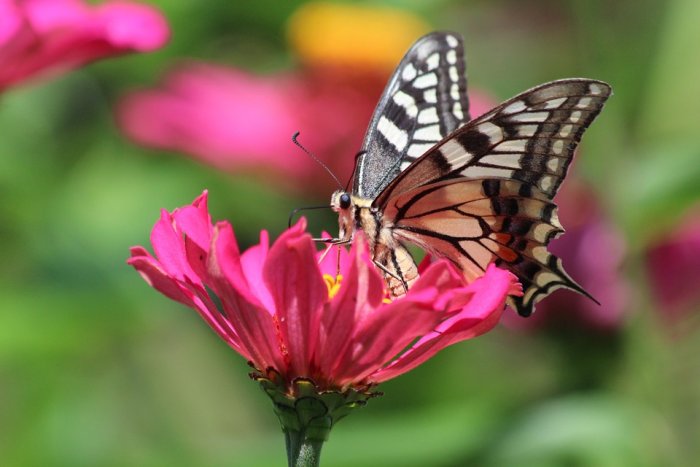Ahimsa – Ancient Non-Violence Concept Teaching Compassion And Love Towards All Living Beings
Ellen Lloyd - AncientPages.com - Ahimsa is an ancient multidimensional concept strongly emphasizing the importance of non-violence and compassion towards all living beings.
Not causing injury includes not only one’s actions but also thoughts and words. The Ahimsa concept is based on the belief that all living creatures have the spark of divine spiritual energy. This means that if you hurt someone, then you ultimately hurt yourself and violence has karmic consequences.
Left: The hand with a wheel on the palm symbolizes the Jain Vow of Ahimsa. The word in the middle is "Ahimsa". Image credit: Stock photo - Middle: Planet Earth. Image Credit: Public Domain - Right - Statue of Mahavira, The torch-bearer of Ahimsa. Image Credit: Public Domain
Ahimsa plays an important part in Jainism, Hinduism, and Buddhism. Many prominent figures strongly believed in practicing Ahimsa, one of them was Mahatma Gandhi (1869-1948) who before becoming a victim of assassination inspired movements for civil rights and freedom across the world.
Ahimsa – Main Pillar of Jainism
The practice of Ahimsa is especially strong among Jains. In Jainism, an ancient religion from India the goal is to achieve the liberation of the soul. This is accomplished through reincarnation.
Like Buddhists, Jains believe in reincarnation, but Jainism is based on stricter ascetic beliefs. According to Jainism, all animals and plants, as well as human beings, contain living souls. All of these souls are equal in value and everyone must be treated with the same respect. Ahimsa’s not harming concept applies not only to humans and larger animals, but also to insects, plants, and microbes.
Jains are strict vegetarians and many refrain from eating root vegetables such as potatoes and onions. This is because consuming the root of a plant means the whole plant dies. Jains can eat the leaves of a plant, but not root vegetables.
Violence in Jainism is only tolerated in self-defense and life-threatening situations.
View Of Ahimsa In Buddhism And Hinduism
Ahimsa is an important concept in Buddhism and Hinduism. However, the observance of ahimsa is not so strict as in Jainism. Emperor Ashoka (304 B.C. – 232 B.C) was an Ahimsa follower. Ashoka believed that all living beings should enjoy security, peace, happiness, and live in freedom. He preached vegetarianism and in his inscriptions of the 3rd century BCE, stressed the sanctity of animal life.
Ahimsa under Hinduism tolerate violence but under special circumstances. Wars must be avoided. Conflicts should be solved through sincere dialogues. Force must be the last resort.
According to Hindus, Ahimsa is not meant to imply pacifism. Using violence in self-defense is allowed, and Hindu scriptures support the use of violence against an armed attacker. This means that criminals are not protected by the rule of Ahimsa.
Morihei Ueshiba, the founder of Aikido stressed that we live in a world full of provoking people and some will out of ignorance, error, or fear, attack other persons or intrude into their space, physically or verbally. Self-defense under Ahimsa is therefore allowed to neutralize the aggression of the attacker and avoid conflict.
Buddhists disapprove of killings because such deeds can result in ending up in the realms of hell. As previously discussed in Ancient Pages, Diyu is the Chinese version of hell partly based on the Buddhist concept of Naraka. According to Chinese beliefs, there is no way to avoid going to Diyu. Everyone who dies must end up in Diyu, but the length of the visit depends on the severity of the sins one committed. It is God Yama who decides when the being’s soul has finished the punishment and can pass from one stage to another.
All life-forms have souls and must be respected, according to the teachings of Ahimsa. Image Credit: Public Domain
Ahimsa is also one of the first disciplines every Yoga student must learn. It is required to be mastered in the preparatory stage (yama), the first of the eight stages that lead to perfect concentration.
Ahimsa can be regarded as part of a religion, but it is also a way of life. As Mahatma Gandhi pointed out, “Ahimsa is in Hinduism, it is in Christianity as well as in Islam.”
"Nonviolence is common to all religions, but it has found the highest expression and application in Hinduism (I do not regard Jainism or Buddhism as separate from Hinduism),” he added.
It’s never wrong to show kindness and Ahimsa reminds us that life and our world would be much better if we did not harm each other and other living beings. Ahimsa simply teaches love and compassion towards all life. It’s something everyone can practice, regardless of religion.
Written by Ellen Lloyd – AncientPages.com
Copyright © AncientPages.com All rights reserved. This material may not be published, broadcast, rewritten or redistributed in whole or part without the express written permission of AncientPages.com
Expand for referencesAltman N, Ahimsa: Dynamic Compassion: A Nonviolence Anthology
Supriya Kelkar, Ahimsa
More From Ancient Pages
-
 Is Mysterious Pokaini Forest An Ancient Healing Center And Anomalous Zone?
Featured Stories | Aug 13, 2018
Is Mysterious Pokaini Forest An Ancient Healing Center And Anomalous Zone?
Featured Stories | Aug 13, 2018 -
 Enigmatic Underground Iron Age Monument At Navan Fort And Its Connection To The Ulster Kings Investigated
Archaeology | Aug 24, 2023
Enigmatic Underground Iron Age Monument At Navan Fort And Its Connection To The Ulster Kings Investigated
Archaeology | Aug 24, 2023 -
 Silver Offers Evidence Viking Age Started Much Earlier Than Previously Thought – Archaeologist Says
Archaeology | Nov 7, 2023
Silver Offers Evidence Viking Age Started Much Earlier Than Previously Thought – Archaeologist Says
Archaeology | Nov 7, 2023 -
 Egyptian Priest Sonchis Of Sais And His Story About Atlantis – Were The Shemsu Hor Survivors Of A Great Catastrophe That Ended The Ice Age?
Civilizations | Jun 8, 2017
Egyptian Priest Sonchis Of Sais And His Story About Atlantis – Were The Shemsu Hor Survivors Of A Great Catastrophe That Ended The Ice Age?
Civilizations | Jun 8, 2017 -
 Mystery Of The Ancient Unknown Mining Civilization In North America – Puzzling Archaeological Discoveries – Part 1
Civilizations | Apr 18, 2022
Mystery Of The Ancient Unknown Mining Civilization In North America – Puzzling Archaeological Discoveries – Part 1
Civilizations | Apr 18, 2022 -
 Walls Of Uruk Built By Sumerian King Gilgamesh 4,500 Years Ago
Featured Stories | Nov 28, 2015
Walls Of Uruk Built By Sumerian King Gilgamesh 4,500 Years Ago
Featured Stories | Nov 28, 2015 -
 Ancient Cave Church Complex In Basarabi, Romania
Civilizations | Dec 11, 2018
Ancient Cave Church Complex In Basarabi, Romania
Civilizations | Dec 11, 2018 -
 Mysterious Inca Citadel With Platforms, Passages And Walls Discovered In Peru’s Rainforest
Archaeology | Oct 15, 2017
Mysterious Inca Citadel With Platforms, Passages And Walls Discovered In Peru’s Rainforest
Archaeology | Oct 15, 2017 -
 Enigma Of The Mysterious Ancient Shining Twins – Were They With Humans From The Beginning Of History? Part 1
Featured Stories | Jun 6, 2020
Enigma Of The Mysterious Ancient Shining Twins – Were They With Humans From The Beginning Of History? Part 1
Featured Stories | Jun 6, 2020 -
 Aboriginal Legends Tell Millennia-Old Stories Of Events In The Sky
Myths & Legends | Mar 6, 2015
Aboriginal Legends Tell Millennia-Old Stories Of Events In The Sky
Myths & Legends | Mar 6, 2015 -
 Wonderful Long-Lived Nymphs In Greek And Roman Mythologies
Featured Stories | Mar 29, 2024
Wonderful Long-Lived Nymphs In Greek And Roman Mythologies
Featured Stories | Mar 29, 2024 -
 On This Day In History: Last Inca Emperor Atahualpa Captured By Francisco Pizarro – On Nov 16, 1532
News | Nov 16, 2016
On This Day In History: Last Inca Emperor Atahualpa Captured By Francisco Pizarro – On Nov 16, 1532
News | Nov 16, 2016 -
 Collapse Of Akkadian Empire Strongly Related To Catastrophic Climate Change
Archaeology | Oct 28, 2019
Collapse Of Akkadian Empire Strongly Related To Catastrophic Climate Change
Archaeology | Oct 28, 2019 -
 What Was The Agriculture Like In Southeast China In The Late Neolithic?
Archaeology | Apr 11, 2022
What Was The Agriculture Like In Southeast China In The Late Neolithic?
Archaeology | Apr 11, 2022 -
 Ancient Tell-Tayinat Inhabitants And Climate Change Resilience – New Study
Archaeology | Oct 30, 2020
Ancient Tell-Tayinat Inhabitants And Climate Change Resilience – New Study
Archaeology | Oct 30, 2020 -
 Iron Age Site Of Khok Phutsa Excavated In Thailand
Archaeology | Apr 15, 2019
Iron Age Site Of Khok Phutsa Excavated In Thailand
Archaeology | Apr 15, 2019 -
 World’s Oldest Marine Navigation Tool Was A Sophisticated Astrolabe
Archaeology | Oct 25, 2017
World’s Oldest Marine Navigation Tool Was A Sophisticated Astrolabe
Archaeology | Oct 25, 2017 -
 Strange Ancient Abduction Case And Mysterious Journey To A Snake King’s Palace In A Parallel World
Featured Stories | May 1, 2021
Strange Ancient Abduction Case And Mysterious Journey To A Snake King’s Palace In A Parallel World
Featured Stories | May 1, 2021 -
 Legendary Ynglings: Descendants Of The Norse Gods And Oldest Scandinavian King Dynasty
Featured Stories | Mar 4, 2023
Legendary Ynglings: Descendants Of The Norse Gods And Oldest Scandinavian King Dynasty
Featured Stories | Mar 4, 2023 -
 World’s Oldest Known Cave Painting – 45,000-Year-Old Depiction Of Wild Pig Discovered At Leang Tedongnge Cave
Archaeology | Jan 14, 2021
World’s Oldest Known Cave Painting – 45,000-Year-Old Depiction Of Wild Pig Discovered At Leang Tedongnge Cave
Archaeology | Jan 14, 2021


